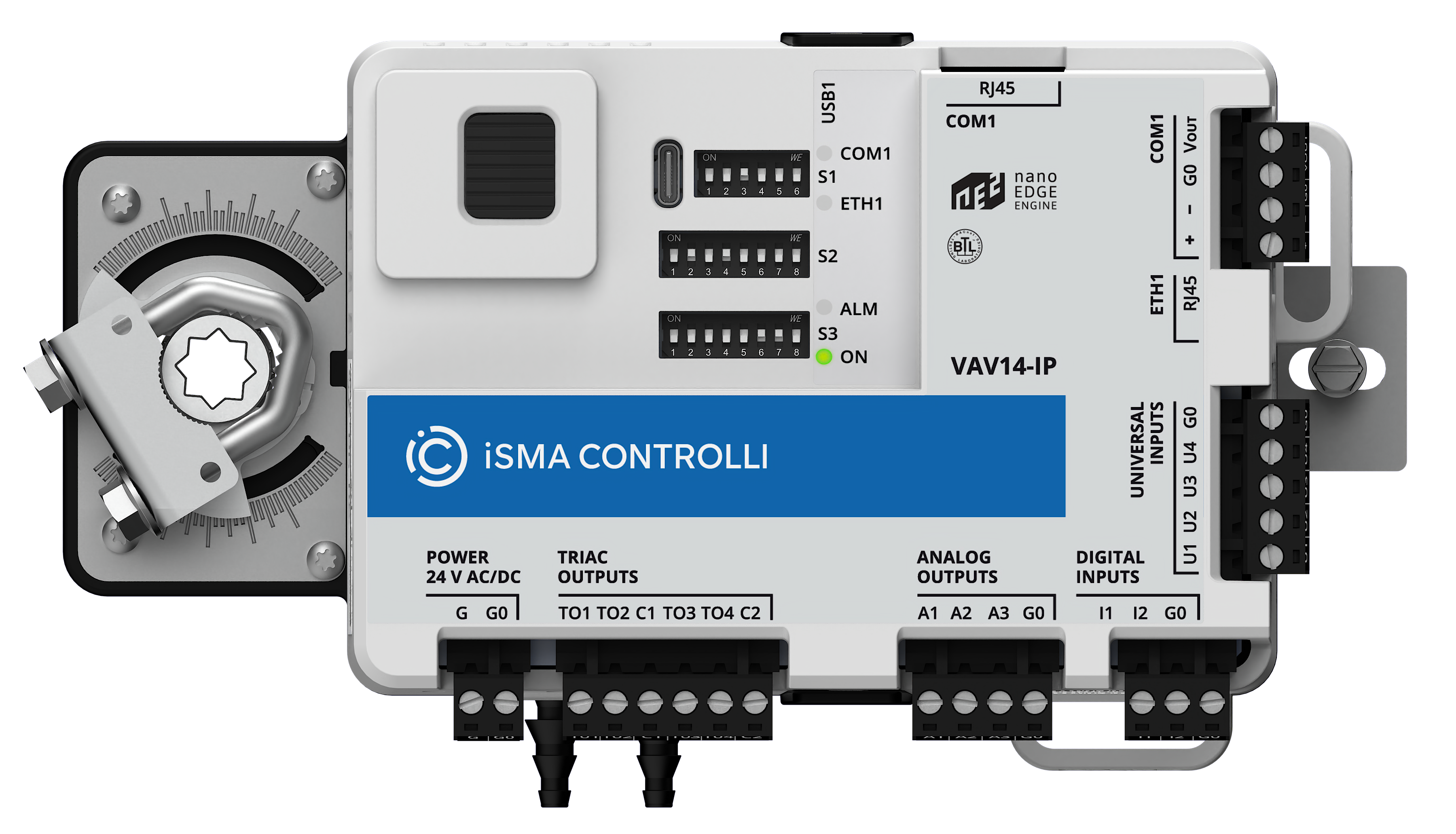Introduction
The VAV14-IP is a configurable and freely programmable controller with BACnet IP, BACnet MS/TP, Modbus TCP/IP, and Modbus RTU protocols onboard. It is delivered with a built-in application, which supports the most popular types of VAV boxes. The possibility of creating a tailor-made application with the power and flexibility offered by the nano EDGE ENGINE makes the controller useful not only for typical VAV boxes but for all types, even the most advanced ones. The VAV14-IP controllers are developed on the nano EDGE ENGINE software platform, which offers cloud connectivity, real-time programming, and automatic exposure of Data Points. This enables a seamless integration with BMS. The platform supports remote control, real-time monitoring, and data analysis, enhancing energy consumption tracking, system performance, and maintenance needs.
Revision History
|
Date |
Manual rev. |
nano EDGE ENGINE OS ver. |
nE2 Link module ver. |
Description |
|---|---|---|---|---|
|
2 Dec 2025 |
1.2.0 |
1.8.0 |
1.8 |
New functionalities:
Improvements:
|
|
28 Aug 2025 |
1.1.0 |
1.7.0 |
1.7 |
New functionalities:
Improvements:
|
|
18 Jun 2025 |
1.0.0 |
1.7.0 |
1.1 |
First edition |
|
15 Jan 2025 |
Beta |
- |
- |
Beta edition |
VAV14-IP Controller
The VAV14-IP is a controller designed for energy-efficient airflow control in HVAC systems. It is equipped with a built-in configurable application and at the same time it can be freely programmable thanks to the versatility of its software platform, the nano EDGE ENGINE, which allows to adapt the controller’s operation to the most advanced systems and equipment.

The controller is equipped with:
-
inputs and outputs (4 universal inputs, 2 digital inputs, 3 analog outputs, and 4 triac outputs);
-
COM1 RS485 port (with RJ45 and screw connectors);
-
ETH1 Ethernet port with 2 fail-safe protected switches (RJ45);
-
USB1 port (USB type C for 5 V power supply and device connection in iC Tool);
-
SD card for the nano EDGE ENGINE software platform;
-
damper actuator powered from the controller;
-
3 DIP switches,
-
LED diodes;
-
2 spigots.
Software Requirements
The VAV14-IP controller if developed for the nano EDGE ENGINE software platform. The controller requires at least the nano EDGE ENGINE OS V1.7.0 to operate; it has a built-in mechanism preventing from downgrading the OS version below V1.7.0.
Tools
The VAV14-IP controller can act either as a configurable device, which operation is based on the default pre-loaded application or as a freely-programmable device, which can be programmed to operate on most advanced VAV installations. For both these ends, there are relevant tools designed to configure or program the device.
Tools that enable configuration of the default application are:
Warning!
Before using the Control Point VAV panel with the VAV14-IP controller, make sure to upgrade its firmware to version V2.5.
Instructions how to upgrade firmware: iSMA Configurator.
Configuration of the VAV Application
To configure the default VAV application, choose a most suited tool and follow the instructions contained in this manual (see the table below).
|
Tool |
App configuration |
Flow settings |
|---|---|---|
|
S3 DIP switch |
- |
|
|
iSMA Configurator |
||
|
Control Point VAV |
||
|
iC Device Manager |
||
|
iC Tool |
||
|
BACnet objects/Modbus registers |
||
Warning!
Please keep in mind that the setting of the first switch on the S3 DIP switch is vital for the configuration possibilities:
-
switch 1 on the S3 DIP switch set to ON: configuration of the fan, reheater, and perimeter types (and referring parameters) possible only from the S3 DIP switch,
-
switch 1 on the S3 DIP switch set to OFF: configuration of the fan, reheater, and perimeter types (and referring parameters) possible from the other tools: Control Point VAV/BACnet/Modbus/iC Configurator/iC Device Manager.
The S3 DIP switch setting holds priority over other tools. If it is set to ON, no change made to the mentioned parameters in any other tool (Control Point VAV or software) will be written to the controller!
Balancing
VAV (Variable Air Volume) balancing is the process of ensuring that a building’s HVAC system delivers the right amount of air to different spaces. The idea of balancing is to find the most optimal operating point of the ventilation system. Proper balancing provides:
-
energy efficiency: minimum consumption of electricity, heating and cooling;
-
user comfort: temperature comfort, noise, air quality.
Read more about the process: Balancing.
Balancing Tools
Tools that enable carrying out balancing actions are:
Freely-programmable Controller
Tools that enable free programming of a user application are:
-
Workbench (using the Niagara nE2 Link module).
